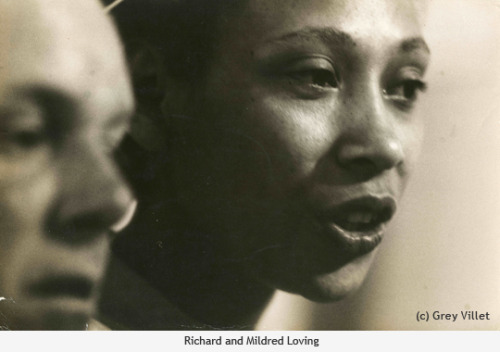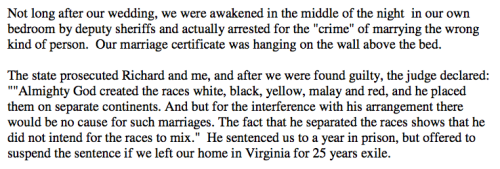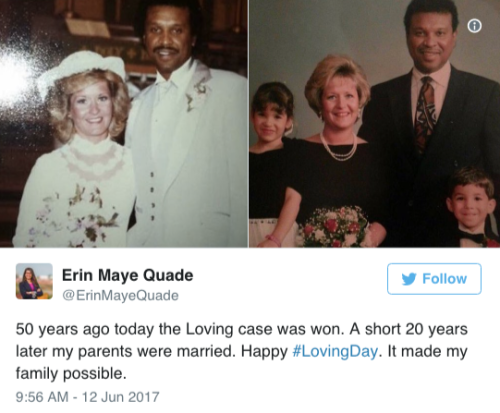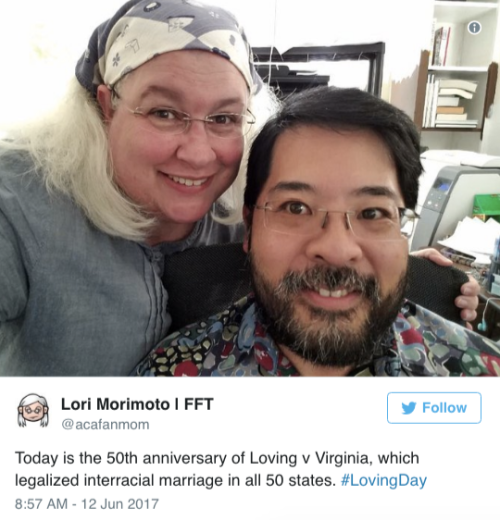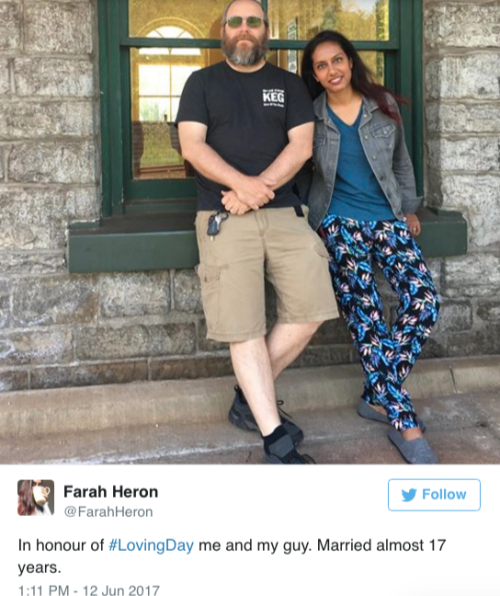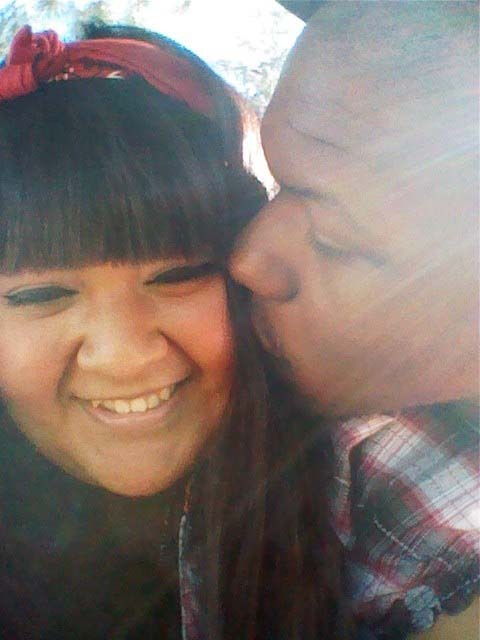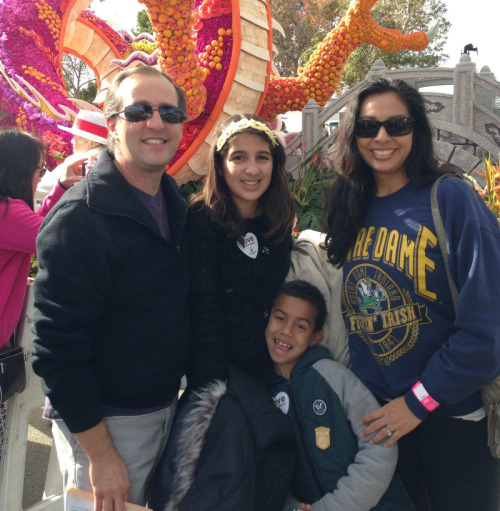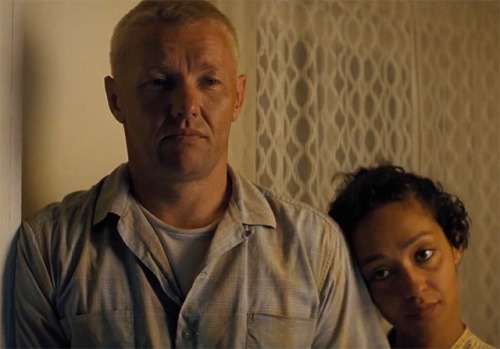#loving v virginia
The late Mildred Loving in 2007, remembering her marriage to Richard Loving and the landmark legal case that struck down state laws banning interracial marriage. The U.S. Supreme Court’s ruling in Loving v. Virginiawas issued on June 12, 1967.
In her later years, Loving became a strong proponent of same-sex marriage.
freedomtomarry has the full text of Loving’s comments here. Image via LovingFilm.com
Post link
This weekend is Loving Day, a celebration of the Supreme Court decision outlawing bans against interracial marriage. Our readers have been sharing their stories of how interracial marriage has affected their lives.
Usually people ask me if my family is OK with my fiancé being black, or my parents ask if his family is OK with me being Mexican. I cannot understand why it is such a problem, but I know generations before me were different.
The fact that me and my fiancé can blend both our families and our cultures makes me feel so happy, because I know that our future kids will be a part of something great. They will be part of two amazing worlds, two amazing cultures and two amazing heritages. Thank you to the Lovings for standing up for love.
– Diana Ortega, Van Nuys
More stories at latimes.com/loving. Share your story using #myLovingDay.
Post link
This weekend is Loving Day, a celebration of the Supreme Court decision outlawing bans against interracial marriage. Our readers have been sharing their stories of how interracial marriage has affected their lives.
I have always known that I was mixed. I can recall sitting in a circle with my elementary school friends saying what our races were and I clearly stated I was half white and half Mexican. I also had a special affinity for the mixed-species Mr. Spock. It didn’t mean that much to me until I entered college at UC Berkeley and became a student activist. After spending several years doing multiracial student organizing I returned home and became active in the multiracial movement through Multiracial Americans of Southern California (MASC). For years I participated in the struggle to change the Census to allow people to mark one or more races: organizing conferences, workshops, letter writing, etc. We were successful in that mission but imagine my surprise when I found they didn’t allow mixed Latino identity. In spite of all my efforts to enable millions to acknowledge all their identities that option was still denied me and likely millions more people.
When it came time to start my own family I chose a Latina friend whom I’ve known since high school. I wouldn’t say I explicitly set out to find a Latina, but rather, when looking for someone with which to spend one’s life, you tend to settle on someone with whom you have something in common. We had a daughter shortly after we married but then five years later chose to adopt a child from LA County. When we heard our son’s story and saw him as a newborn we couldn’t say no. When we made our decision at the time it really didn’t matter much to us what his race was. It wasn’t until we began introducing him to friends and family that we realized the significance of our transracial adoption.
Some like to believe that love is all you need to raise a child. But how do we show our love for our kids? We do what all parents do, we try to prepare them for life on their own. We live in a racist world, and our children, as people of color, will be subject to that racism at some point in their life. In our son’s case it happened before he was even one year old. So many people were curious about his race and one went so far as to comment how “you can’t even tell he’s black.” Why should it matter if you could tell he was mixed black unless you believed for some reason that was shameful? Being multiracial he was very fair skinned to start but has since darkened up somewhat. Today we don’t go out of our way to teach our kids about racial injustice, but we do try to instill in them a sense of pride in all of who they are. They will learn soon enough all the many ways racial discrimination can affect them. For now, we want them to know how their race makes them special.
Thomas Lopez, president of Multiracial Americans of Southern California (MASC)
More stories at latimes.com/loving. Share your story using #myLovingDay.
Post link
Richard Loving, a white man, met Mildred Jeter, a family friend who was of African and Native American descent, when both were teenagers, and their relationship quickly blossomed into romance. In June 1958 the couple drove 80 miles from their native Virginia, where so-called “anti-miscegenation” laws made interracial unions illegal, to exchange their vows in Washington, D.C. Five weeks later, police officers walked through their unlocked front door and awakened the newlyweds in the middle of the night. When a sheriff asked what he was “doing in bed with this lady,” 24-year-old Richard simply pointed at the marriage certificate hanging on the wall. Arrested and charged with “cohabiting as man and wife, against the peace and dignity of the Commonwealth,” the Lovings were sentenced to one year in prison or a 25-year exile from their home state.
The couple relocated to Washington, where they lived for five years and had three children. Missing their family and friends back home, in 1963 they contacted U.S. Attorney General Robert F. Kennedy, who referred them to the American Civil Liberties Union. Volunteer lawyers ultimately took the case all the way to the Supreme Court, which in the landmark Loving v. Virginia decision of 1967 unanimously ruled that bans on racial intermarriage in Virginia and 15 other states were unconstitutional. Richard was killed in a car crash in 1975, and Mildred remained in the Virginia house he had built her until her death in 2008.
Post link
“Joel Edgerton truly embodies the role of Richard with his slimmed down appearance, cropped blonde hair and stoic swagger. Ruth Negga shines as Mildred too, her pensive stares and large eyes conveying a multitude of emotions. [Director] Nichols places focus on how their relationship shifts under the strain, and how their love eventually prevailed against the odds.”
– ‘The List’ review of “Loving”
Post link

